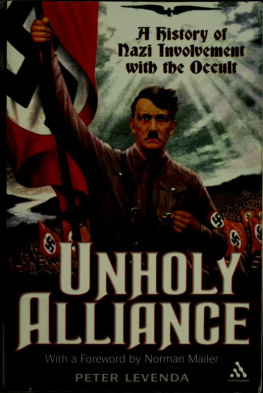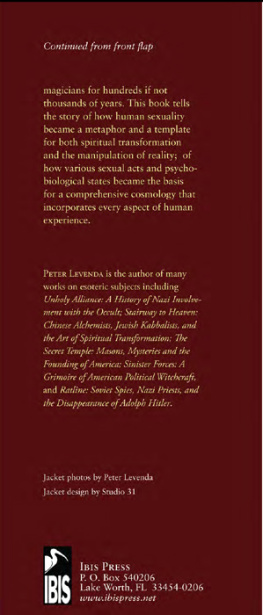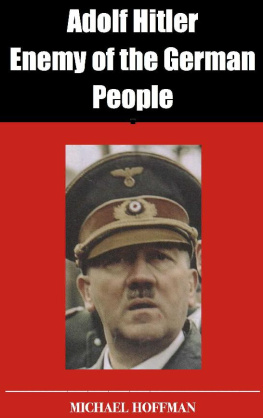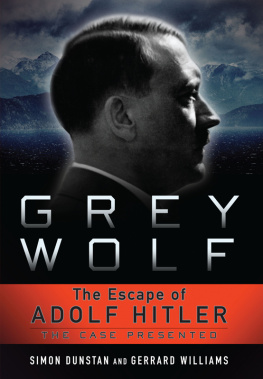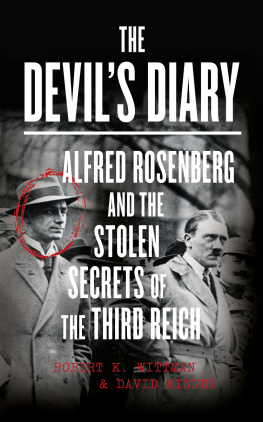RATLINE
Soviet Spies Nazi Priests and the Disappearance of Adolf Hitler
PETER LEVENDA
While searching through the jungles of Java in 2008, gathering material for his book Tantric Temples: Eros and Magic in Java, the author came upon evidence of a Nazi escape route that led from Europe to Argentina, Tibet, and eventually Indonesia. The rumors were persistent; the evidence suggestive. Tantra is about magic and power. So was the Third Reich. Was it possible that the world's greatest symbol of evil had actually escaped Berlin in 1945? In time, more information came to light. In December of 2009, it was revealed that the skull the Russians claimed was Hitler'ssalvaged from the bunker in 1945was not that of Hitler at all. The news made headlines around the world. Then in 2010, files from the Office of Special Investigations of the Justice Department were declassified, revealing a history of American intelligence providing cover for Nazi war criminals.
RATLINE
All this was inspired by the principlewhich is quite true within itselfthat in the big lie there is always a certain force of credibility; because the broad masses of a nation are always more easily corrupted in the deeper strata of their emotional nature than consciously or voluntarily; and thus in the primitive simplicity of their minds they more readily fall victims to the big lie than the small lie, since they themselves often tell small lies in little matters but would be ashamed to resort to large-scale falsehoods. It would never come into their heads to fabricate colossal untruths, and they would not believe that others could have the impudence to distort the truth so infamously. Even though the facts which prove this to be so may be brought clearly to their minds, they will still doubt and waver and will continue to think that there may be some other explanation. For the grossly impudent lie always leaves traces behind it, even after it has been nailed down, a fact which is known to all expert liars in this world and to all who conspire together in the art of lying.
Adolf Hitler , Mein Kampf, vol. I, ch. X

His primary rules were: never allow the public to cool off; never admit a fault or wrong; never concede that there may be some good in your enemy; never leave room for alternatives; never accept blame; concentrate on one enemy at a time and blame him for everything that goes wrong; people will believe a big lie sooner than a little one; and if you repeat it frequently enough people will sooner or later believe it.
OSS Psychological Report on Adolf Hitler

An exhibition has opened in Russia showing visitors part of a skull which officials claim was Adolf Hitler's. The fragment, with a bullet hole through it, has been kept in a secret vault for decades
The authenticity of the claim has been questioned since Moscow first announced it had the fragment in 1993.
Hitler biographer, Werner Maser, said the fragment was fake. However, director of the exhibition Aliya Borkovets insisted that no doubts remain about its origin.
BBC News 26 April 2000

Deep in the Lubyanka, headquarters of Russia's secret police, a fragment of Hitler's jaw is preserved as a trophy of the Red Army's victory over Nazi Germany. A fragment of skull with a bullet hole lies in the State Archive.
So when American academics claimed that DNA tests showed the skull to be that of a woman, they challenged a long-cherished tale of the hunt for Hitler's remains.
The Times, 9 December 2009
RATLINE
Soviet Spies
Nazi Priests, and
the Disappearance of
Adolf Hitler
Peter Levenda

IBIS PRESS
Lake Worth, FL
Published in 2012 by Ibis Press
A division of Nicolas-Hays, Inc.
P. O. Box 540206
Lake Worth, FL 33454-0206
www.ibispress.net
Distributed to the trade by
Red Wheel/Weiser, LLC
65 Parker St. Ste. 7
Newburyport, MA 01950
www.redwheelweiser.com
Copyright 2012 by Peter Levenda
All rights reserved. No part of this publication may be
reproduced or transmitted in any form or by any means, electronic
or mechanical, including photocopying, recording, or by any information storage and retrieval system, without permission in writing from Nicolas-Hays, Inc. Reviewers may quote brief passages.
Please note that every attempt has been made to determine the proper copyright holder of the images presented here. We apologize for any inadvertent errors and request you contact us with corrections.
ISBN 978-0-89254-170-6
Library of Congress Cataloging-in-Publication Data
Levenda, Peter.
Ratline : Soviet spies, Nazi priests, and the disappearance of Adolf Hitler / Peter Levenda.
p. cm.
Includes bibliographical references.
ISBN 978-0-89254-170-6 (alk. paper)
1. Hitler, Adolf, 1889-1945Exile. 2. War criminalsGermanyHistory20th century. 3. Fugitives from justiceGermanyHistory20th century. 4. NazisMiddle EastHistory. 5. NazisSouth AmericaHistory. I. Title.
DD247.H5L395 2012
940.53'145--dc23 2012005055
Book design and production by Studio 31
www.studio31.com
Printed in the United States of America
Contents
Introduction
For when the truth is with us in one place, it is buried in another.
Norman Mailer
September, 2011
T he sun was going down over the field of tombs. I picked my way gingerly over the stone slabs that were set down in an almost haphazard fashion, threatening to twist an ankle with every step. Leading the way was a plainclothes security guard. Around me a small crowd was gathering: young, dangerous-looking men with curious expressions. I was the only foreigner in the cemetery, probably the only foreigner for miles.
But I was not the only foreigner they had ever seen. Recently, visitors had been coming from Europe and the Middle East to pay their respects in this nondescript plot in an obscure graveyard on the far side of the world.
Thirty-two years ago, I had been on a similar expedition and had nearly disappeared in the torture cells of a Nazi estate in the Andes mountains. I had been alone that time, trusting to luck and my instincts to survive what was certainly a foolish mission to uncover one of the links of the Ratline in Pinochet's Chile. This time, after a bone-rattling eight hour drive through small towns, tea plantations, and remote forests, I achieved my objective just as the muezzin began calling the faithful to prayer.
I hoped that was a good sign.
I was there with a professor of anthropology from Indonesia's largest university. She served as interpreter and camera operator, a task far beneath her but one that she shouldered without complaint. She would provide my cover story to the guards, that I was a relative from abroad seeking the grave of his uncle. But the guards knew exactly whom I was seeking. The name on the tombstone had become famous, but the real identity of the corpse was more famous still.
As I finally reached the tomb, a stone box surrounded by a neat wrought-iron fence and gate, one of the guards leaned down over it and reverently whispered the name of the cemetery's most notorious inhabitant:
Hitler.
How I came to be there, and why I began to take this outrageous story seriously, is the theme of this book. I'd been researching Nazism for decades, with a particular emphasis on Nazi mystical ideas as well as on the escape routes used by Nazi war criminals to escape justice, the rat lines. I have appeared numerous times on television documentaries concerning the strange beliefs that fueled the Nazi Party. I've been asked to speak on this subject to groups in Asia, Europe and North America, and have been interviewed for radio and podcast more times than I can remember. But in all of those years of describing and trying to explain the motives of Nazi war criminals I had never seriously entertained the theory that Hitler had escaped Berlin at the end of the war. While I like to think I have an open mind, the idea of Hitler in Argentina was just too paranoidand just too wrongto be believed. After all, there was ample evidence to prove that Hitler committed suicide in the Berlin bunker on April 30, 1945. I had written about it. I knew the facts of the case. There was nothing to question.
Next page

